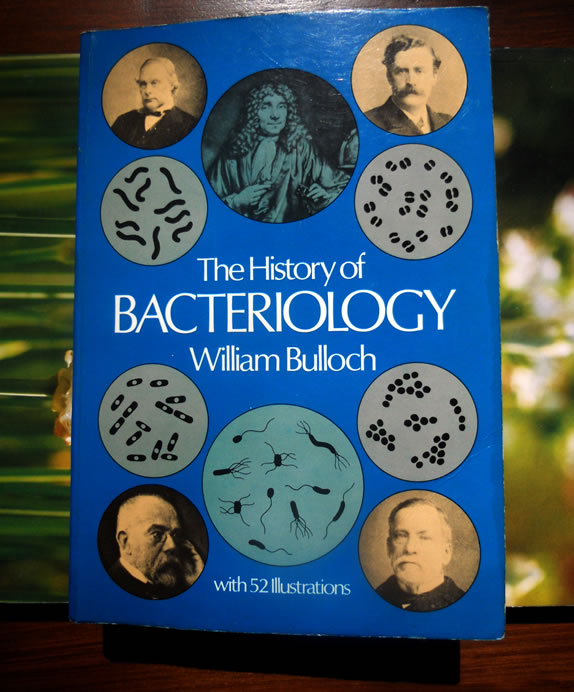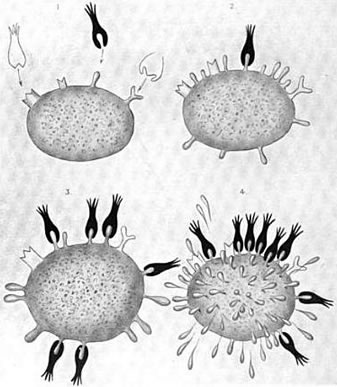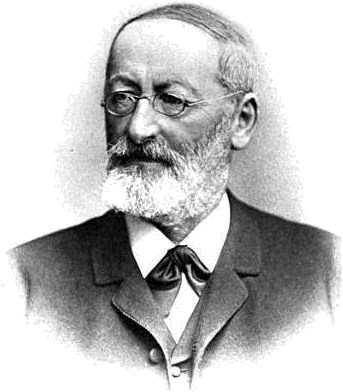Copyright © 2011 Mednansky Institute, Inc.
The History of Bacteriology, a masterly scholarship by William Bulloch (1868-1941), was originally published by Oxford University Press in 1938. As an expanded version of the Heath Clark Lectures delivered by William Bulloch in January and February 1937 at the London School of Hygiene and Tropical Medicine, it provides a most complete and compelling history of bacteriology up to the 20th century. It uncovers the contributions by men of great merit, eminent or forgotten researchers the world had heard too little, whose work established bacteriology as a blossoming branch of science. In the book preface dated June 1938 William Bulloch stated, "The collection of material for a history of bacteriology is a work of years and is not always easy or possible unless one has access to the largest libraries. Had it been easy it would not have been left so long undone. I have gone carefully through the literature contained in this book."
The bibliography organized by chapters is extensive, and a special section of biographical notices gives brief account of 'some of the early workers in bacteriology'. The chronology is topical, with eleven particular chapters concentrating on different aspects of bacteriology. Contents include: Ancient doctrines on the nature of contagion – Contagium Animatum – Fermentation – Spontaneous generation and heterogenesis – Putrefaction and putrid intoxication, including ptomaines – discussion on pyaemia, septicaemia, and surgical sepsis – Specific element in disease – Classification of bacteria – Cultivation of bacteria – Pasteur's work on attenuation of virus – History of doctrines of immunity. The book is nicely illustrated and includes medallion portraits.
Dover edition of The History of Bacteriology first published in 1979.The unabridged Dover edition was reprinted by special arrangement with Oxford University Press

Portraits from top left to right, bottom left to right: Joseph Lister (1827-1912), Antony van Leeuwenhoek (1632-1723), Alexander Ogston (1844-1929), Robert Koch (1843-1910), Louis Pasteur (1822-1895)
At one time bacteria were considered by some as belonging to the animal kingdom, by others the plant kingdom. They were likewise reclassified from the Algae to the Fungi. In rare instances they were not even recognized as living entities and, prior to Ferdinand Cohn (1828-1898), many opposed their classification in genera and species. "His [Cohn] researches were the result of many years' laborious work and he was successful in disentangling almost everything that was correct and important out of a mass of confused statements on what at the time was a most difficult subject to study. His work was entirely modern in its character and expression, and its perusal makes one feel like passing from ancient history to modern times", writes William Bulloch.
Classification of bacteria by German botanist Ferdinand CohnFigure 24 of The History of Bacteriology, Chapter 8

Cohn divided bacteria in four groups (tribes): 1- The Spherobacteria (spherical bacteria) 2- The Microbacteria (short rods) 3- The Desmobacteria (straight filaments) 4- The Spirobacteria (spiral filaments)
The last chapter, History of doctrines of immunity, brings focus on the early development of immunology, its bacteriological roots and complexity. Pioneer works are briefly outlined, and special tribute given to Paul Ehrlich to whom "from the scientific point of view the highest praise must be given", as worded by William Bulloch. Paul Ehrlich's theory of immunity under the name of 'side-chain' or 'receptor' theory does indeed warrant deserved consideration, and was a necessity for his valuable experimental work.
Paul Ehrlich's side-chain theory, Figure 35 and 36 of The History of Bacteriology

Eight diagrams presenting Ehrlich's views on the method of toxin action and antitoxin formation during the process of immunization, from Croonian Lecture: On Immunity with Special Reference to Cell Life by Paul Ehrlic, Proceedings of the Royal Society of London, 1899, vol. 66, pp. 424-448, read March 22, 1900, Full Text at the Proceedings of the Royal Society of London
Excerpt: … the cell become, so to say, educated or trained to reproduce the necessary side-chains [the antitoxins] in ever-increasing quantity [coming to exist in a free state]
In his closing statement, William Bulloch wrote, "From the small beginnings in 1675, when the great Dutch microscopist Antony van Leeuwenhoek first saw with his lenses minute living creatures in rain water, down to the end of the nineteenth century, a new science has developed and has reached immense dimensions. I have attempted to trace how this knowledge has been built up, often by laborious efforts, by tortuous routes, and sometimes through trackless wastes. But one thing is certain: the science of bacteriology is built on broad and sound foundations." Indeed man has largely built on the thriving science by improving traditional microbiological processes and developing entirely new industries.
Suggested Reading:Paul Ehrlich and William Bulloch; A Correspondence and Friendship (1896–1914), Clio medica, 1968, vol. 3, pp. 65–84
Papers and Reports Presented to the Section of Bacteriology and Chemistry: The Development of American Bacteriology by H. L. Russell, in Public Health Papers and Reports, 1903, vol. 29, pp. 329-337, at PubMed Central. H. L. Russell (1866-1954) was the ninth President of the Society of American Bacteriologists (later American Society for Microbiology)
Clifford Dobell's labor of love: Antony van Leeuwenhoek and his 'little animals' at Minst.org Online Library, 2010
Note: From The History of Bacteriology preface "… I should like to express my thanks to Clifford Dobell, F.R.S., for help and advice generously given over many years, and for the loan of valuable papers and rare books which I could not have obtained otherwise without a great deal of trouble", William Bulloch, June 1938


Portrait is from 'Ferdinand Cohn: Blätter der Erinnerung' by Pauline Cohn, 1901
Minst.org Online Library Index